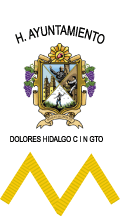
by Daniel Rentería, 30 June 2025, using coat of arms at Wikimedia Commons
image: [1] from masdeaca.com

Last modified: 2025-07-26 by daniel rentería
Keywords: dolores hidalgo | guanajuato | bandera municipal y escudo municipal (guanajuato) | escudo del municipio (guanajuato) | bandera del municipio (guanajuato) | héraldica municipal de guanajuato |
Links: FOTW homepage |
search |
disclaimer and copyright |
write us |
mirrors

by Daniel Rentería, 30 June 2025, using coat of arms at Wikimedia Commons
image: [1] from masdeaca.com
See also:
The council uses a gonfalon, but they informed me the adoption date of it is unknown. It is white and has triangle edges and fringing at the bottom. In the center is the municipal coat of arms, over
text reading "DOLORES HIDALGO C IN GTO".
Daniel Rentería, 30 June 2025
.gif)
from Wikimedia Commons
The coat of arms was established during the term of Municipal President Anselmo Portillo García (1955-1957), being designed by the lawyer Juan Antonio Zárate Sandoval, the process of adoption being unknown. Description according to the Encyclopedia of Municipalities and Delegations of Mexico:
The shield, firstly, contains rolls to the manner of papyrus found in its upper part, in both sides, and coming out of the ends two clusters of grapes, fruit that Don Miguel Hidalgo introduced during his years as priest in this city. The cover of the shield is found divided by diagonal lines forming four triangles; in the upper triangle is Don Miguel Hidalgo with the standard of the Virgin of Guadalupe that he took from the sanctuary of Atotonilco, in attitude to rally his people to incite them to the fight for liberty; in the central-left triangle, the principal facade of the parish of Señora de los Dolores is found, where Don Miguel Hidalgo, priest of this town, gave the Grito de Independencia the dawn of 16 September 1810; in the center-right triangle a potter is appreciated seated before a throne modeling a clay pot, industry that Don Miguel Hidalgo also implemented; in the lower triangle, an Indian is contained with a sling in his right hand in attitude of launching a rock to hunt turtledoves which are found in the branch of a tree, in allusion to the primitive name of Cocomacán; the lower part of the shield contains a Latin inscription that says Dulce et Decorum Est [Sweet and Dignified it is to die for the Fatherland] and the upper part is crowned by two concentric circles, found in the interior a Phrygian cap from which two rays of light emanate.
Daniel Rentería, 30 June 2025
Anything below this line was not added by the editor of this page.